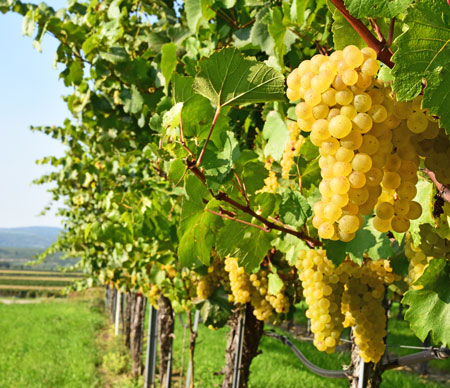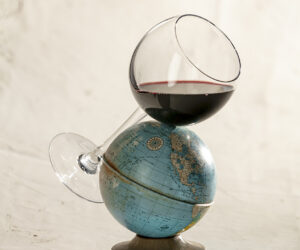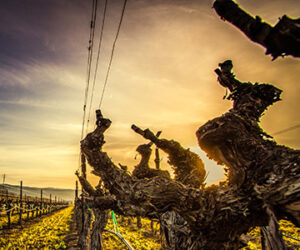
Towards the end of the fall 2018 harvest I was looking for a little respite in my calendar, and I came across an appointment scheduled for a Friday night in late November simply titled “Grüner Tasting.” It piqued my interest and I got a little excited about it but didn’t have a clue how it got on my calendar. At the time I didn’t know much about the grape, so evidently when it went on my calendar it was for good reason. Time to learn something new, if not just to find out where the grape got its name. The full name is Grüner Veltliner . . . how cool is that? The name could double for a really sleek and classy locomotive on some exotic Eastern European railway. Eastern Europe was correct, but the locomotive part is pure fantasy. So Grüner Veltliner it is, henceforth known simply as Grüner or GV, and in more recent times, “gru-vee.” It is really groovy that some writers report that they hold up to the best Burgundian white wines and one blind tasting reported gru-vee at the top, but the difference in scores among judges on the panel was 4 points total. You’ve got to love the subjectivity of wine writers!
In my wine drinking circle, Grüner is not exactly a household word, or the wine that comes home from Trader Joe’s or the Grocery Store Outlet, but if you look through restaurant wine lists you are almost certain to find it on the best lists. This is what got me excited at the 2019 WineMaker Magazine Conference in Traverse City, Michigan. My wife and I had just come into town and were looking for a restaurant. The wine list was secondary to our hunger pangs. So we sought out a restaurant based on the menu posted on the internet, mac and cheese was the lure. Seemed odd for a restaurant named Smoke and Porter. But that was the place we chose, and it was ten minutes away. Perfect! When we arrived, the menu was exactly what we thought it would be, all things smoked, even the Caesar salad! Turns out the “porter,” which we thought was a beer, was referring to the person bringing your food to the table. After ordering our meals I scanned the wine list to find the perfect match. At the bottom was a 2013 Grüner Veltliner produced by Water Fire Vineyard in the local town of Kewadin. It was a local Michigan wine, with the winery being about 20 minutes away. I asked the waitstaff some questions and the bar manager (who I believe was also the owner) returned. The wine arrives along with the food and we begin to experience one of the best meals we have had just by searching on the internet for the “best restaurants in Traverse City.”
To confuse matters, Grüner Veltliner is not a member of the Veltliner grape family.
Grüner is a white grape variety and by modern standards relatively new to the world. The first mentions in the annals of history date back to the seventeenth century. Recent DNA profiling of it shows Grüner to be a natural cross between Traminer (Savagnin Blanc) and a specific vine in eastern Austria found near the town of St. Georgen am Leithagebirge. This location is not far from the triple point where Hungary, Slovakia, and Austria come together. Evidently, this one vine is the only known survivor of its kind and has a very unique DNA profile. The vine, having a familial relationship to Muscat, to avoid confusion, is known locally as the “St. Georgen Vine.” The vine is now a protected national monument after vandals attacked it in 2011, but efforts are underway to propagate it and make wine from it. I could not tease out of the resource why this was not done earlier. All it would have really taken is some cuttings during the pruning season and sticking them in the ground or sending them to the nursery for grafting onto rootstock. But I digress . . .
To confuse matters, Grüner Veltliner is not a member of the Veltliner grape family at all (although Grauer Veltliner has been shown to be a color mutant of Grüner Veltliner.) The history becomes complicated with unresolved questions regarding lineages, so I will leave that out.
Viticulturally, the white grape is very fruitful with small greenish-yellow berries. It is susceptible to downy and powdery mildews as well as something new to me, the grape rust mite. The mite has been reported in vineyards of Europe, the Pacific Northwest, Australia, and Korea. Well-timed applications of foliar insecticides and dry flowable sulfur help control it. While it can be devastating, some silver lining lies in that it seems to be snack food for other beneficial insects and mites leading to a biodiversity of beneficial organisms in the vineyard. For more information, enter into your favorite search engine the key words “grape rust mite” or you can simply talk to Wes Hagen to unlock that encyclopedia of knowledge.
A natural cross, as mentioned earlier, I would like to think Grüner was bred for this region of Eastern Europe. Longtime readers of my column know how I feel a variety should be appropriate for a region and Grüner seemed to take off there. In Austria, it is the country’s most widely planted grape, with over 42,000 acres (~17,000 ha). It flourishes along the Danube River, and in the other wine-growing regions of Weinviertel, Burgenland, and Neusiedlersee. The Austrians have set up a quality system similar to other wine-producing countries. The DAC as it is known recognizes Grüner in the Kremstal, Kamptal, Traisental, and Weinviertel regions. Across Austria’s borders, collectively amounting to about 18,000 acres (~7,300 ha), it is grown in the Czech Republic, Slovakia, Hungary, and Bulgaria. In Western Europe, it is grown in Germany and Italy, and in France a few experimental plots exist but it is not sanctioned by any local AOC. It is becoming fashionable to plant it elsewhere in the world. New Zealand and Australia introduced it about ten years ago. In the US, Oregon is reported to have the most plantings followed by California. In 2016, California reported about 170 acres (70 ha). Washington and British Columbia report acreage as well as New York, Pennsylvania, Maryland, Virginia, and New Jersey. Missing from these acreage reports, was the great state of Michigan. Who would have thought? The trip to Traverse City turned out to be a Grüner quest.
Wine quality can be very high, even with yields of up to 6 tons per acre (13.4 tonne/ha). The California acreage in 2016 produced about 650 tons (590 tonne), resulting in a yield of 3.7 ton/acre (8.3 tonne/ha) on average. But looking at historical records, yields as high as 7 ton/acre (15.7 tonne/ha) have been seen. The wines are reported to be “stunningly concentrated and age-worthy.” They are best made in a dry style that is with no remaining fermentable sugar. Grüner Veltliner is made into sparkling versions and in Germany and Austria, these are referred to as sekt wines. Made in largely the traditional méthode Champenoise style of secondary fermentation in the bottle, but there are also examples of the Charmant style, where the carbonation is produced in a pressurized tank. As with most white wine fermentations, a slow cool fermentation, 55–60 °F (13–16 °C) preserves the fruit characters and enhances formation of the fermentation bouquet esters. There are also sweeter versions being made as Auslese and Trokenberenauslese bottlings. The latter referring to late-harvest berries being individually selected for their sweetness and degree of infection with Botrytis or noble rot.
Because of the many styles possible it is hard to nail down the best food pairings, but we have to complete that Traverse City restaurant experience. We started with the wood-grilled Caesar salad with smoked tomatoes. The all-stainless version of the Grüner matched perfectly. The salad was followed by smoked chicken soup with leeks and asparagus. Asparagus is a difficult pairing, but the Grüner did fine. For the entrée, our mouths watered over the panko crusted walleye, again a perfect match for the delicateness of the wine. I do have to add, we were craving the descriptions of the mac and cheese just to get us in there. Big question — how was the mac and cheese? Turns out we never had it, even on our second visit, because both the wine list and the dinner menu had such depth, the mac and cheese had to take a backseat. Our experience proved something we learned in Europe some year’s back about northern latitude grapes and the wines they produce: When well made, they pair well with just about anything.
So whatever happened to that calendar entry, from what seems like so long ago? I made telephone calls and sent emails trying to figure the time and place of the tasting. There were a few of the obvious hopefuls, trying to not look stupid because I obviously forgot about them. No such luck. Perhaps I would have had more success with social media, but alas in the end, I missed the Grüner tasting, if it even ever existed. I have since sought out Grüners just to fill that void the lonely, cold, November Friday night created, and spotting that Grüner on the list really made that dining experience so memorable. We even sought out the winery the next day to taste new vintages. The Winemaker, Chantel, and her tasting room crew made us feel right at home, tasting through several wines, and even some pulled from the warehouse just for us! I have found many stunning wines at extremely reasonable price points since then. Grüner is described as “fashionably versatile, and top quality” by Jancis Robinson, I think she needs to add groovy for the grape and cool for the grape’s name to make her descriptions complete. Check it out, I don’t think you’ll be disappointed. The only disappointment I had was not making it to the tasting.
Grüner Veltliner Recipe
Ingredients
100 lbs. (45 kg) Grüner Veltliner fruit or 6 gallons (19 L) commercially available juice (clarified)
Distilled water
10% potassium metabisulfite (KMBS) solution (Weigh 10 grams of KMBS, dissolve into about 75 milliliters (mL) of distilled water. When completely dissolved, make up to 100 mL total with distilled water.)
5 grams Lallemand QA23 yeast (Premier Cuvee can also be used as a substitute)
5 grams Fermaid K (or equivalent yeast nutrient)
5 grams Di-ammonium Phosphate (DAP)
Malolactic bacteria culture — CHR Hansen Viniflora® Oenos
Other equipment or needs
5-gallon (19-L) carboy
6-gallon (23-L) carboy
6-gallon (23-L) plastic bucket
Airlock/stopper
Racking hoses
Equipment cleaning and sanitizing agents (Bio-Clean, Bio-San)
Inert gas (nitrogen, argon, or carbon dioxide will do)
Refrigerator (~45 °F/7 °C) to cold settle the juice. (Remove the shelves so that the bucket will fit.)
Ability to maintain a fermentation temperature of 55 °F (13 °C). TIP: Use a 33-gallon (125-L) plastic can as a water bath. Place ice blocks in the water to maintain a relatively constant temperature. This will be your refrigeration system for peak fermentation. If you have other means to keep things cool, of course use that.
Thermometer capable of measuring between 40–110 °F (4–43 °C) in one degree increments
Pipettes with the ability to add in increments of 1 mL
Clinitest® tablets to measure residual sugar
Ability to test or have testing performed for sulfur dioxide
Ability to test or have testing performed for malolactic fermentation
Step by step
- Crush and press the grapes. Do not delay between crushing and pressing. Move the must directly to the press and press lightly to avoid extended contact with the skins and seeds.
- Transfer the juice to a 6-gallon (23-L) bucket. During the transfer, add 16 milliliters of 10% KMBS solution (This addition is the equivalent of 40 mg/L (ppm) SO2). Move the juice to the refrigerator.
- Let the juice settle at least overnight. Layer the headspace with inert gas and keep covered.
- Measure the Brix and acidity.
- Adjust the acidity to 6.0–7.0 g/L. (If the acidity is greater than 7.0 g/L, consider the option of inoculating for the malolactic fermentation (MLF) and the completion of the alcoholic fermentation described below.)
- When sufficiently settled, rack the juice off of the solids into the 6-gallon (23-L) carboy.
- Prepare yeast. Heat about 50 mL distilled water to 108 °F (42 °C). Measure the temperature. Pitch the yeast when the suspension is 104 °F (40 °C). Sprinkle the yeast on the surface and gently mix so that no clumps exist. Let sit for 15 minutes undisturbed. Measure the temperature of the yeast suspension. Measure the temperature of the juice. You do not want to add the warm yeast to your cool juice if temperature difference exceeds 15 °F (8 °C). To avoid temperature shock, acclimate your yeast by taking about 10 mL of the juice and adding it to the yeast suspension. Wait 15 minutes and measure the temperature again. Do this until you are within the specified temperature range. Do not let the yeast sit in the original water suspension for longer than 20 minutes. When the yeast is ready, add it to the fermenter.
- Add Fermaid K or the equivalent yeast nutrient.
- Initiate the fermentation at room temperature (~65–68 °F/18–20 °C) and once fermentation is noticed, (~24 hours) move to a location where the temperature can be maintained at 55 °F (13 °C).
- Two days after fermentation starts, dissolve the DAP in as little distilled water required to completely go into solution (usually ~20 mL). Add directly to the carboy.
- Normally you would monitor the progress of the fermentation by measuring Brix. One of the biggest problems with making white wine at home is maintaining a clean fermentation. Entering the carboy to measure the sugar is a prime way to infect the fermentation with undesirable microbes. The presence of noticeable fermentation is good enough. If your airlock becomes dirty by foaming over, remove it, clean it, and replace as quickly and cleanly as possible. Sanitize anything that will come in contact with the juice.
- Leave alone until bubbles in the airlock are about one bubble per minute, usually about 2–3 weeks.
- Measure the Brix. The wine is considered dry, or nearly dry when the brix reaches -1.5 °Brix or less. If it is dry, and you’re planning for MLF, raise the temperature to about 65 °F (18 °C) to inoculate with bacteria.
- Monitor the progress of the malolactic fermentation using thin layer chromatography.
- If you did not inoculate for MLF, then add 3 mL of fresh KMBS (10%) solution per gallon (3.8 L) of wine. If you did inoculate, perform this step once MLF is complete. This is the equivalent to ~40 ppm addition. Transfer the wine to the 5-gallon (19-L) carboy and lower the temperature to 38–40 °F (3–4 °C).
- After two weeks, test for pH and SO2 and adjust as necessary to attain 0.8 ppm molecular SO2. (There is a simple SO2 calculator at www.winemakermag.com/guide/sulfite). Check the SO2 in another two weeks, prior to the next racking and adjust while racking. HINT: Rack to another sanitized 5-gallon (19-L) carboy, or your bucket. In the case of the latter, clean the original carboy and transfer the wine back to it. This is done at about 4–6 weeks after the first SO2 addition. Once the free SO2 is adjusted, maintain at the target level by monitoring every 3–4 weeks.
- At about three months you are ready to bottle. Be sure to maintain sanitary conditions while bottling. Once bottled, you’ll need to periodically check your work by opening a bottle to enjoy with friends.






